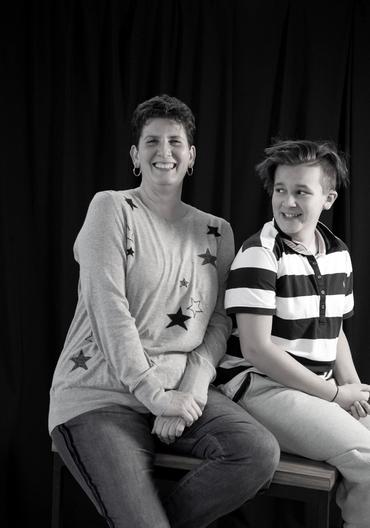Henry and Davie - our story
Davie has a “bilateral conductive hearing loss” to a profound level. Henry (father) tells us about navigating the early days as a family.
The Story of Davie Livingstone
Before I became a father, I had been equated with hearing loss through members of my immediate family. Growing up many of the kids I knew wore hearing aids and relied on lip reading and sign language as their way communication.
Skipping forward a lifetime I met my partner Carol and we decided to have kids. The pregnancy was as normal as it could be, strange cravings, lots of medical appointments and Dads classes learning about the birth all set to prepare me for those eternal hours spent in a birthing suite watching my beloved experience something that not even the bravest man would dare dream of.
After a relatively straight forward birth our son David was born, he had all the fingers and toes that he should have but his hearing did not function as it should, that coupled with a respiratory issue Davie was transferred to the Children’s Hospital (RCH) for additional care and monitoring. Due to structure of his lower jaw Davie struggled to feed and breath and needed round the clock care from the fabulous doctors and nurses in NICU.
After a long stay in hospital we finally got to take our baby home to start the journey of becoming a family. With a list of clinical appointments and a state of heightened anxiety we visited Hearing Australia to review his hearing loss and talk about options and support. The diagnosis the audiologist gave us was that Davie had a bilateral conductive hearing loss to a profound level. Now even having spent a lifetime mixing with deaf people that sentence seemed like mumbo jumbo, other words used were Microtia and Atresia. In a nutshell Davie's hearing loss was caused by the lack of an ear canal and middle ear on the left and partial formation of both on the right, thus he had no way of receiving sound into either Cochlear rating the loss as profound. Luckily in the mid 1970s an ENT surgeon in Sweden had formulated a way to conduct sound through the skull to the Cochlear using a specialist hearing device called a BAHA. At 3 weeks old David wore his first hearing aids by way of a soft head band and received sound in the simplest form.
The primary reason for fitting Davie with aids was to help him develop speech and through a little research, we came to understand that a child’s speech development starts in the womb and meets its peak in the first 24 months. We also recognised that we live an oral society and for him to live a full and fruitful life he would need speech. As a family we advocated for the best support we could provide, through early intervention and medical treatment. As with all kids Davie grew, he learned to walked and with a little delay found words, the clarity was not that of his peers but what Carol and I were happy about was that he was speaking and was a happy and active little boy.
After 5 years of hard work and early intervention we enrolled Davie into Mount View Primary School, Glen Waverly. A mainstream public school it offers a high level of education to all who attend but specialises in supporting deaf children through their learning journey. Currently the school supports around 50 children with hearing loss by way of technology, teaching techniques and social inclusion. Davies just started year one and is progressing well in all areas of education, his speech has come along in leaps and bounds and he has a strong group of friends, both hearing typical and impaired. Outside of school he has many interests, he loves to be outside, riding his bike, playing sports and pushing the boundaries of safety, he loves Lego, trains and playing board games but he doesn’t like fruit and vegetables very much. Recently he enrolled in Joey Scouts attending regular meetings, participating in activities such as building dens, ice blocking and going away on camp. Many of his activities require adult support to help him negotiate physical and mental challenges but as a family we take them in our stride and look to the future.



